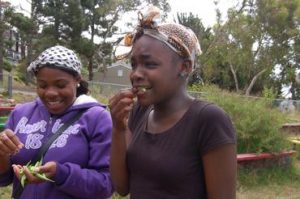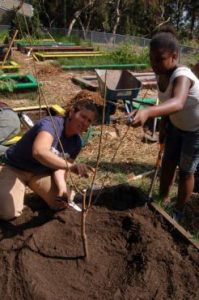Author: Starhawk
Published in Communities Magazine Issue #153
Patrick Whitefield calls permaculture “the art of designing beneficial relationships.” Most permaculturalists are expert at understanding the relationships between land forms and water harvesting, or between soil micro-organisms and plant health. But when it comes to our human relationships, we often founder. Nurturing the vegetables in the garden is a lot easier than nurturing our connections to the people who decide where to plant the vegetables and who will water them. Meeting the needs of chickens or goats is far easier than meeting the needs of your fellow farmers. Many permaculture groups, like many intentional communities, start up with the highest ideals, only to come apart in painful discord and strife.
Diana Leafe Christian, who studied successful ecovillages and intentional communities, found that “No matter how visionary and inspired the founders, only about one out of ten new communities actually get built. The other 90 per cent seemed to go nowhere, occasionally because of lack of money or not finding the right land, but mostly because of conflict. And usually, conflict accompanied by heartbreak. And sometimes, conflict, heartbreak and lawsuits.” [Diana Leafe Christian, Creating a Life Together: Practical Tools to Grow Ecovillages and Intentional Communities, New Society, Gabriola Island, BC, 2003, p. 5.]
Our human relationships are our biggest constraining factor in the work of transforming society. So, is there a way to do them better?
I’ve been working in collaborative and collective groups of many sorts for more than four decades now, and this question has always been in the forefront of my mind. I’ve been through many painful learning experiences of my own, and observed many groups struggle with conflict. I’ve founded one organization, Reclaiming, an extended network focused on earth-based spirituality, that is now more than 30 years old. I’ve worked in hundreds of other groups and facilitated thousands of meetings. I teach permaculture courses called Earth Activist Trainings that include group dynamics and decision-making along with a grounding in spirit and a focus on organizing. Over the last few years I’ve taught a number of social permaculture courses, several in collaboration with Bill Aal and the late Margo Adair of Tools for Change. I’ve compiled much of my own learning into a new book, The Empowerment Manual: A Guide for Collaborative Groups (New Society Publishers, October 2011).
My practice of permaculture informs my approach to group social design and conflict, and my understanding of group dynamics informs my practice of permaculture. Permaculture principles can be translated into guidelines and approaches that will help us to work together more effectively and joyfully as we strive to change the world. Here are a few of my Social Permaculture Principles:
1) Abundance springs from relationships:
True abundance, whether that’s measured in garden produce or ecstatic experiences, has little to do with how much stuff we have, but rather, how rich we are in relationships. So—cherish your relationships. Value them. Give them time and attention. Nurture and maintain them. When conflict arises, don’t simply discard people, but learn the skills and tools to work things through. Nurture your relationship to your inner self and spirit, as well. As you face your own shadows and develop your own strengths, your relationships with others will be enriched and deepened.
2) Recognize and work with patterns:
Permaculture teaches us to look for patterns in nature and apply that knowledge to our designs. We can also look for social patterns. Hierarchy is a pattern we’re all familiar with, but when we try to work collaboratively, outside of a command and control structure, we encounter different challenges. Recognizing them can help us structure our groups more effectively. Collaborative structures differ from hierarchies in many ways:
• Communication is more complex: In a hierarchy, we generally know to whom we report and where we are on the chain of command. A collaborative group, however, is more like a web, with many possible pathways for any message to follow to get from person A to person B. People get left out of the loop, often unintentionally, because the loop becomes a knot or a snarl. In a well-run top-down structure, we know who is responsible for carrying out decisions. In a circular structure, we may make a decision but each person in the circle may assume someone else is going to carry it out.
So, pay rigorous attention to communication. Whenever a decision is made, ask, “Who else needs to know about this?” “Who will inform them?” “How will the rest of us know this is done?” When a plan is made, ask “Who will be responsible for making sure this is carried out?” Doing so can forestall much conflict and hurt feelings
• Mom can’t make the kids behave: In a hierarchy, generally someone at the top can say, “Okay, you two stop fighting and make up.” In a collaborative group, there’s no Mom, no Dad, but we carry over our family patterns and expect that someone, somehow, can step in and sort things out for us. When they don’t, groups often fall apart because they have no way to move conflict out of the system or resolve it.
So, build in conflict resolution systems, mediation, and clear agreements. Develop skills in conflict transformation, and devote group time and resources to training in communication and mediation. Conflict will always arise in groups. Just as you put an overflow on a pond to handle the hundred-year storm, design an “overflow” for group conflict so that it doesn’t erode trust and enthusiasm or burst the dam and flood the production fields.
3) Feed what you want to grow:
Industrial agriculture works on the principle: “Kill the pests!” If bugs attack a field, nuke them with chemicals! Organic farmers know that attacking pests with powerful toxins only breeds resistance. Instead, we create healthy soil that provides what our plants need to repel pests. We plant flowers that attract beneficial insects that keep the chompers in check. We look at insect damage as information—something is out of balance.
In our social relations, too often we revert to “Kill the pests!” Instead of attacking the people whose behavior offends us or trying to drive them out of the group, we can look at conflict as information. Something in the group is out of balance. Somehow we’ve created a habitat that allows destructive behavior to thrive. How do we give a competitive edge to the behaviors that we want?
When we fear conflict, we may resort to gossip and backbiting. Instead of directly confronting Scabiosa Sue when she hurts my feelings, I complain about her to Lennie Legume or post a scathing denunciation on the listserv that goes out to a hundred people around the world, most of whom don’t know either of us. The result is a toxic miasma of resentment, rumors, and malicious tattling.
We can clear the air by creating a group culture of direct engagement. When we learn to embrace conflict, to openly argue for our ideas or values without resorting to personal attack, we create an atmosphere that discourages malicious gossip and scapegoating and encourages respect. We can train our group members to respond to a bid for a trash-fest by saying, “How can I support you, Starhawk, in talking directly to Scabiosa about your feelings?” Or perhaps, ”Can I be of service to you in helping arrange a mediation?” When one of our friends opens a conversation by saying “I really shouldn’t tell you this…” we can learn to say “I’m so glad you recognize that! Now, about that other topic…”
4) Value diversity:
In nature, diversity gives an ecosystem resilience. In groups, a diversity of opinion, backgrounds, ages, ethnic and class backgrounds, and experiences can broaden our perspective and let us see multiple facets of an issue. If we want a diverse group, we must make the extra effort to bring people in who represent that diversity, and to do it in a meaningful way, not as tokens: early in our process so that a wide range of people help form the group and participate in the creative aspects of the project. We can build alliances with diverse communities not just by inviting them to support our work but by sharing information and resources, educating ourselves about their history and current struggles, and showing up in support of their issues.
5) Develop a culture of respect, kindness, and trust:
Trust is built in many ways: by creating opportunities to share something of our lives and feelings, by encouraging people to argue passionately for their ideas and positions while still respecting their opponents’ right to differ, by meeting responsibilities and building a track record of dependability, and by sharing risks together.
Kindness, respect, compassion, and encouragement are the compost tea of relationships—they feed all the beneficial impulses. When we respect one another’s ideas, think well of one another’s motives, and support one another’s visions, we create a high-energy atmosphere in which creativity flourishes.
These five principles are merely a sketch of how we might begin to look at our human groups as ecologies. As I said, I’ve just written a book on the subject—and that is only a bare beginning. Social permaculture is an emerging discipline, and the study of human behavior, in groups and outside of them, is a lifelong pursuit. But as we become more skillful at nurturing our human relations, we will become more effective in every aspect of our work. At this crucial time for the earth, we need the power of creative, effective, loving, and joyful groups to move us forward. When we can be as skillful in our human interactions as we are in our garden designs, we’ll become an invincible force of healing for our communities and our earth.

















lonegreyrabbit
this is a very important topic. i hope some day i’ll be able to find a community where i can practice social as well as permaculture of the land.